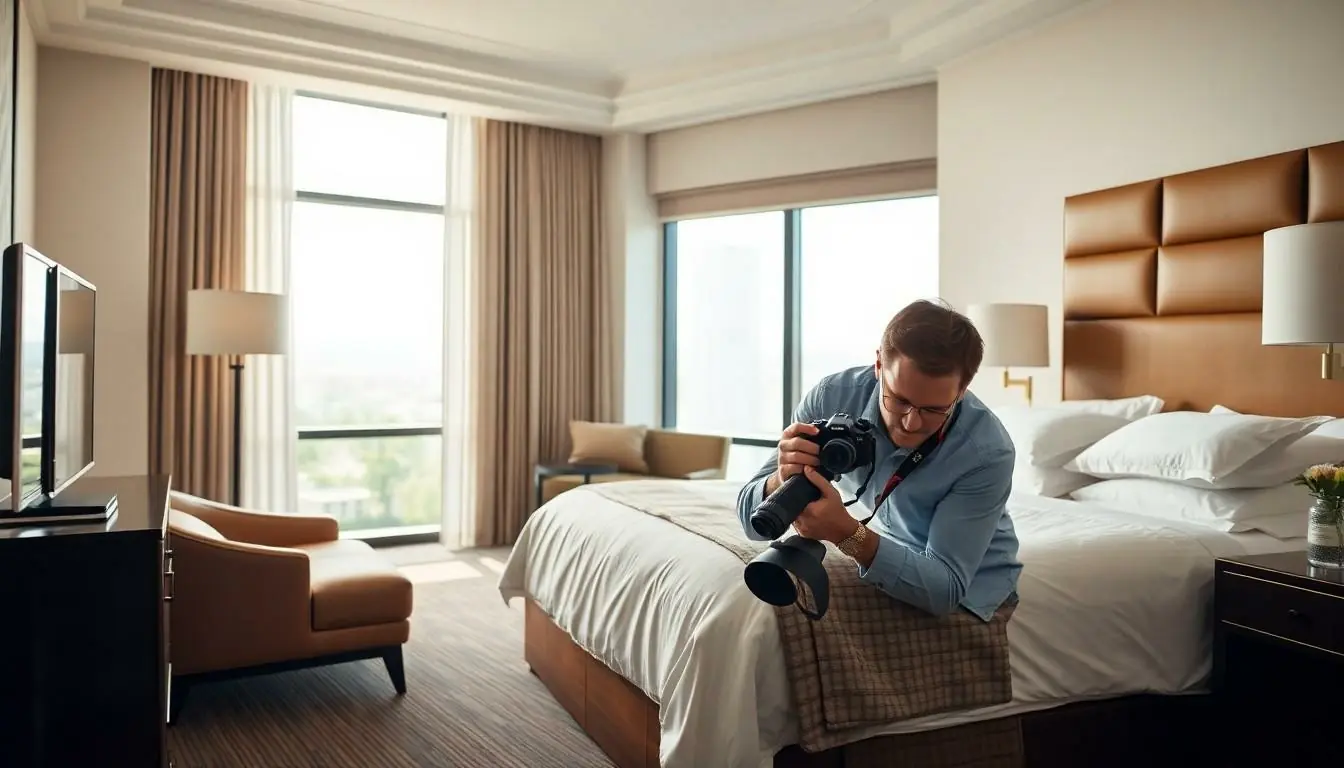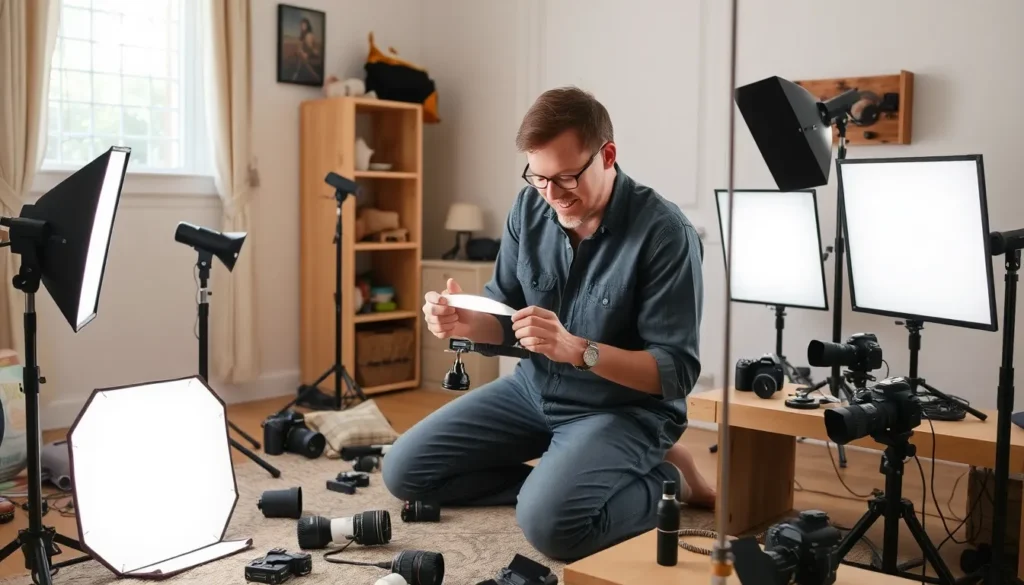In a world where first impressions count more than ever, hotel photography is the secret sauce that can turn a casual browser into a booking ninja. Imagine scrolling through a sea of bland images and suddenly stumbling upon a stunning shot of a sunlit suite that makes you feel like you’re already on vacation. That’s the magic of great hotel photography—it’s not just about capturing a room; it’s about selling an experience.
Table of Contents
ToggleImportance Of Hotel Photography
Hotel photography plays a crucial role in attracting potential guests by creating lasting first impressions. High-quality images entice viewers, making them eager to book their stay.
Impact On Guest Bookings
Effective hotel photography significantly influences guest bookings. 90% of travelers consider visuals vital in the decision-making process. A well-composed image of a luxurious suite can evoke a sense of relaxation and excitement. Guests often choose hotels based on how appealing the photos appear. Turning casual browsers into enthusiastic bookers often hinges on striking imagery that showcases a property’s best features. Images that highlight unique amenities can also serve to differentiate one hotel from its competitors.
Enhancing Brand Image
Strong hotel photography enhances overall brand image. Consistent and professional visuals create a cohesive identity that resonates with potential guests. Photos that reflect a hotel’s atmosphere and style foster trust and authenticity. Visitors perceive high-quality images as a reflection of service quality and attention to detail. Memorable visuals contribute to positive associations with the brand. Elevated brand perception often leads to increased guest loyalty over time. Each image shared reinforces the intended message and establishes a visual narrative that engages travelers.
Techniques For Capturing Stunning Hotel Photography

Capturing stunning hotel photography involves a combination of techniques that highlight a property’s best features. Effective strategies can significantly enhance visual appeal and attract guests.
Utilizing Natural Light
Natural light plays a crucial role in photography. It enhances the colors and texture of rooms. Timing photos during the golden hour, shortly after sunrise or before sunset, provides soft, flattering illumination. Windows act as natural light sources, illuminating spaces without the harshness of artificial lighting. Capturing hotel images during these hours can create a warm, inviting atmosphere that draws viewers in. Consider shooting a few angles, as the direction of light can dramatically change the feel of a room.
Composition Tips
Composition greatly impacts the storytelling aspect of hotel photography. Rule of thirds, widely used in photography, guides the placement of subjects within the frame. Placing key elements off-center leads to more dynamic and engaging images. Incorporating leading lines, such as hallways or staircases, directs the viewer’s gaze throughout the photograph. Framing elements like doors or windows can add depth and context to the image. A variety of shots, including wide angles to capture full rooms and close-ups for intricate details, ensures a comprehensive visual journey through the hotel’s offerings.
Essential Equipment For Hotel Photography
Effective hotel photography requires specific equipment to capture stunning visuals. This includes cameras and lenses that can handle various settings and lighting conditions.
Cameras And Lenses
A high-quality camera significantly impacts hotel photography. DSLR or mirrorless cameras provide the best results due to their versatility and image quality. Prime lenses offer sharpness and enhanced low-light performance. Consider using wide-angle lenses to showcase spacious areas in hotel rooms and lobbies. Standard zoom lenses also effectively cover different perspectives. Look for lenses with image stabilization to minimize blurriness in dynamic settings. A superior camera setup makes it easier to capture enticing images that attract potential guests.
Lighting Equipment
Lighting equipment plays a crucial role in hotel photography. Natural light creates warm, inviting images, while additional artificial lighting can enhance details in dimly lit areas. Softboxes and LED panels provide controlled light that reduces harsh shadows. Flash units can effectively illuminate specific subjects, like beautiful decor or amenities. Understanding lighting techniques elevates the overall quality of photos. Utilizing reflectors also helps bounce light into darker corners, ensuring every detail is visible. Proper lighting equipment enhances the overall aesthetic and appeal of hotel images.
Post-Processing Tips For Hotel Images
Post-processing significantly enhances hotel images, making them more appealing to potential guests. Several crucial techniques and editing software can elevate the visual quality.
Editing Software Recommendations
Photoshop and Lightroom are two leading choices for professional photographers. Both programs offer powerful editing tools that allow adjustments to exposure, contrast, and color balance. Capture One stands out for its robust tethering capabilities, ideal for studio settings. Nik Collection enhances creativity with unique filters and presets. Affinity Photo provides a budget-friendly option without sacrificing features, catering to those seeking effective alternatives.
Enhancing Color And Contrast
Boosting color and contrast creates stunning visual impacts. Increasing vibrancy adds life to images without oversaturation. Adjusting contrast enhances depth, making details pop. Selective color adjustments can refine specific tones, drawing attention to key features. Utilizing curves helps control tonal range, ensuring highlights and shadows remain balanced. Applying sharpening techniques reinforces clarity while maintaining a natural look, ensuring images remain inviting.
Hotel photography plays a crucial role in attracting potential guests and driving bookings. By capturing stunning visuals that highlight a property’s unique features and ambiance, hotels can create an emotional connection with travelers. High-quality images not only enhance the guest experience but also strengthen brand identity and trust.
Investing in professional photography techniques and equipment ensures that hotels present themselves in the best light. With the right approach to lighting composition and post-processing, hotels can elevate their visual storytelling. Ultimately, compelling imagery transforms casual browsers into enthusiastic bookers, making hotel photography an essential element of a successful marketing strategy.



